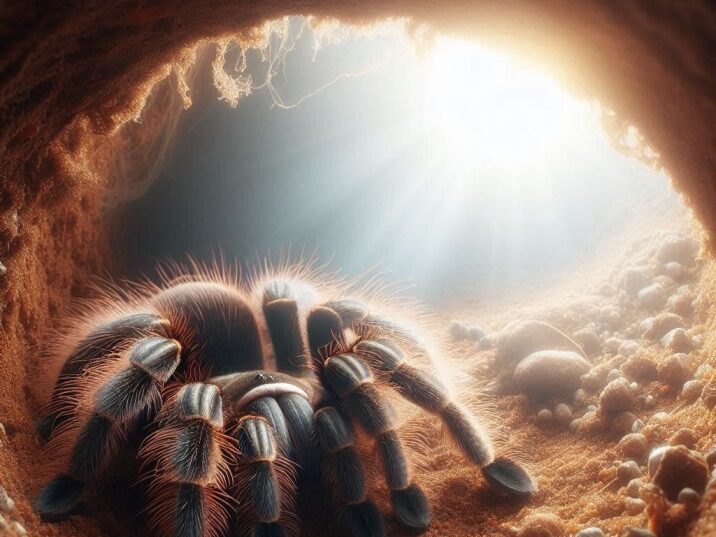Introduction
Tarantulas are fascinating creatures that capture the curiosity of many, especially those interested in exotic pets or the mysteries of nature. But have you ever wondered, “What do tarantulas do all day?” Unlike more active animals, tarantulas have a unique lifestyle that’s both intriguing and a bit surprising. In this article, we’ll explore the daily habits of tarantulas, uncover what they do during the day, and dive into the details of their behavior. Whether you’re a spider enthusiast or just curious about these eight-legged creatures, this guide will provide you with everything you need to know.

Table of Information: What do Tarantulas Do all Day
| Aspect | Details |
|---|---|
| Habitat | Underground burrows, trees, and secluded spots |
| Diet | Insects, small animals |
| Activity Level | Mostly nocturnal, limited daytime movement |
| Daily Behavior | Hiding, web-building, waiting for prey |
| Lifespan | 10-30 years (depending on species) |
What Do Tarantulas Do All Day
Table of Contents
Understanding Tarantula Behavior
1. Tarantulas Are Mostly Nocturnal
One of the most important aspects of tarantula behavior is that they are primarily nocturnal. This means they are most active at night when the environment is cooler, and there’s less chance of encountering predators. During the day, tarantulas tend to stay hidden in their burrows or other sheltered spots.
- Nocturnal Habits: At night, tarantulas come out to hunt, explore their surroundings, and sometimes search for a mate. They use their heightened senses to detect vibrations in the ground, which helps them locate prey.
2. Daytime: A Time for Rest
What Do Tarantulas Do All Day so during the day, tarantulas are not very active. They typically spend this time resting in their burrows or hiding under rocks, logs, or other secluded areas. This period of inactivity is crucial for their survival, as it conserves energy and keeps them safe from predators.
- Resting in Burrows: Tarantulas often create or find burrows where they can retreat during the day. These burrows are carefully constructed to provide protection and maintain a stable environment.
3. Web-Building and Maintenance
While tarantulas are not like typical spiders that spin elaborate webs, they do produce silk, which they use for different purposes. During the day, tarantulas might engage in web-building activities, such as lining their burrows with silk or creating trip lines around their hiding spots to detect approaching prey.
- Silk Usage: The silk produced by tarantulas is not used to trap prey but rather to reinforce their burrows and create a secure environment. They also use it to cover the entrance of their burrow when they are inside, creating a barrier between them and potential threats.
4. Waiting for Prey
Tarantulas are ambush predators, meaning they don’t actively hunt but rather wait for prey to come to them. Our question was what do Tarantulas do all day so During the day, they remain still, conserving energy and relying on their excellent camouflage to stay hidden. If a potential meal happens to pass by, the tarantula is ready to strike with incredible speed.
- Ambush Strategy: By remaining motionless, tarantulas can catch their prey off guard. When an insect or small animal approaches, the tarantula uses its powerful legs to pounce, injecting venom to subdue its meal.
5. Mating and Reproduction
Though not a daily activity, mating is a significant part of a tarantula’s life. During the mating season, male tarantulas may spend their nights searching for females. When they find a potential mate, they perform a careful dance to avoid being mistaken for prey.
- Mating Rituals: The mating process can be risky, especially for the male, as female tarantulas sometimes attack them. However, if successful, the female will lay eggs, which she carefully guards in a silk cocoon.
Tarantulas in Captivity vs. Wild Tarantulas
1. Captive Tarantulas
Tarantulas kept as pets have a slightly different daily routine compared to their wild counterparts. While they still adhere to their natural instincts, the controlled environment of captivity affects their behavior.
- Feeding Schedule: Pet tarantulas are typically fed on a regular schedule, which means they may not engage in hunting behaviors as often. However, they still exhibit natural behaviors like burrowing and web-building.
2. Wild Tarantulas
In the wild, tarantulas face a variety of challenges, from finding food to avoiding predators. Their daily activities are heavily influenced by their environment, and they have to be more cautious and resourceful to survive.
- Survival Tactics: Wild tarantulas must constantly be on alert for predators and other threats. Their burrows are more critical in the wild, providing shelter from the elements and a safe space to retreat.
The Importance of Environment for Tarantulas
The environment plays a crucial role in a tarantula’s daily life. Whether in the wild or captivity, their surroundings affect their behavior, health, and overall well-being.
1. Temperature and Humidity
Tarantulas are sensitive to temperature and humidity levels. In the wild, they choose their habitats based on these factors, while in captivity, it’s essential to maintain proper conditions.
- Ideal Conditions: Tarantulas thrive in environments that mimic their natural habitats. For many species, this means warm temperatures and moderate humidity.
2. Hiding Spots and Burrows
Having a secure place to hide is vital for a tarantula. Burrows not only protect them from predators but also provide a stable microclimate that helps regulate their body temperature.
- Creating Burrows: In captivity, providing a suitable substrate that allows tarantulas to dig and create burrows is essential. In the wild, they may dig their own burrows or take over abandoned ones.
Common Myths About Tarantulas
Tarantulas are often misunderstood, leading to various myths and misconceptions. Let’s debunk some of these myths:
1. Myth: Tarantulas Are Aggressive
While tarantulas may look intimidating, they are generally not aggressive toward humans. Most tarantulas prefer to avoid confrontation and will only bite if they feel threatened.
- Reality: Tarantulas use their size and appearance as a defense mechanism, but they are not naturally aggressive creatures.
2. Myth: All Tarantulas Are Poisonous
All tarantulas possess venom, but it is not deadly to humans. In fact, their venom is primarily used to subdue prey and is usually harmless to people.
- Reality: The venom of most tarantulas is comparable to a bee sting in terms of toxicity.
Conclusion: What Do Tarantulas Do All Day
Tarantulas might seem mysterious, but their daily routine is a fascinating blend of survival instincts, natural behaviors, and unique adaptations. From hiding in burrows during the day to hunting at night, these creatures lead a life that’s both simple and complex. Understanding what tarantulas do all day gives us a deeper appreciation of these remarkable animals. Whether you’re a seasoned arachnid enthusiast or just starting to learn about them, there’s always something new to discover about the world of tarantulas.
5 FAQs About What Do Tarantulas Do All Day
- What do tarantulas eat?
- Tarantulas primarily eat insects, but larger species can also consume small animals like lizards or mice.
- Are tarantulas dangerous to humans?
- No, tarantulas are not dangerous to humans. Their venom is usually no more harmful than a bee sting.
- How long do tarantulas live?
- Tarantulas can live for 10-30 years, depending on the species and gender.
- Do tarantulas make webs like other spiders?
- Tarantulas don’t make webs to catch prey, but they do produce silk for lining their burrows and creating trip lines.
- Can tarantulas be kept as pets?
- Yes, tarantulas are popular pets among arachnid enthusiasts due to their relatively low maintenance needs.

